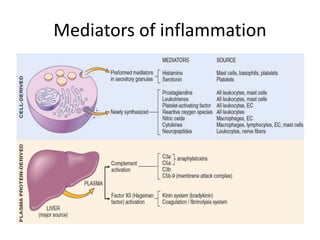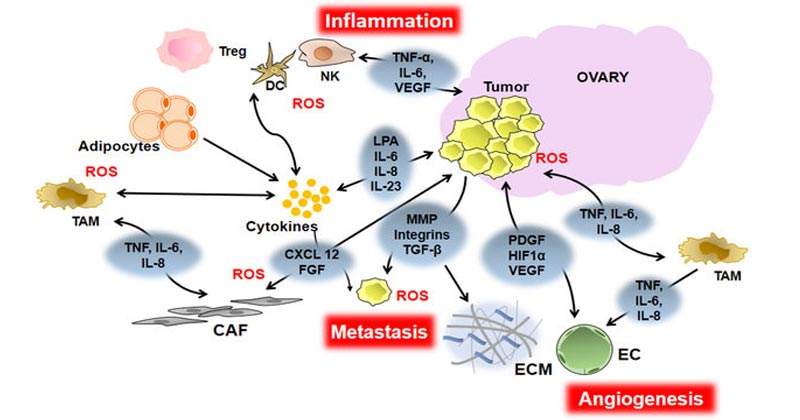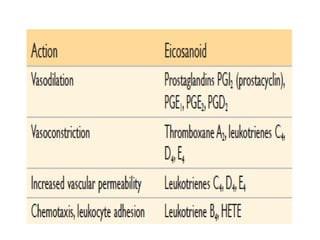Chemical Mediators of Inflammation Include Which of the Following
Histamine is released mostly by basophils and mast cells. Pain Chemical mediators of inflammation include a.
Chemical Mediators Of Inflammation Histamine Serotonin Pathology Made Simple
Chemical mediators released from cells.
. Tumor necrosis factor-α TNF-α is a cytokine that activates nuclear factor-κB NFκB one of the central transcription factors in inflammatory processes. The secondary mediators have similar or opposite effect. Accompanying inflammation include the following.
Asked Oct 28 2016 in Nursing by DebiWebi. Chemical mediators of inflammation include histamine Answer choice C. The vascular and cellular events of acute inflammation are brought by a variety of chemical mediators derived either from plasma or from cells.
The most important kinin is bradykinin which increases vascular permeability and vasodilation and importantly activates phospholipase A 2 PLA 2 to liberate arachidonic acid AA. Stimulate release and mediation of target cells themselves. Inflammatory mediators are released and inflammatory cells are activatedChoice 5.
Chemical action one or many target cells with different effects. Fever and pain are mediated by prostaglandins IL1 TNF and kinins d. Which of the following are among the most common indicators of inflammation.
Albumin and Fibrinogen B. This is the best-known chemical mediator in acute inflammation. Massive release of inflammatory chemical mediators which becomes a life-threatening allergic reaction that can cause cardiovascular shock and death.
Widely-distributed in tissues and found in blood basophils and platelets but the PREDOMINANT source is mast cells that are localized to CT. Anatomy and Physiology questions and answers. These chemicals called endogenous chemical mediators cause vasodilatation emigration of neutrophils chemotaxis and increased vascular permeability.
Leukotrienes and prostaglandins in the initial phase of inflammation followed by arachidonic acid-derived lipoxins 7 10 and the novel families of docosahexaenoic acid DHA and eicosapentaenoic acid EPA-derived mediators namely. Chemical mediators of inflammation include which of the following. Too much collagen between tissue in the body cavity.
This condition is known as. Chemical mediators released during the inflammatory response include. The inflammatory response can be provoked by physical chemical and biologic agents including mechanical trauma exposure.
C5a LTB4 IL8 are chemotactic c. Exogenous endotoxins Endogenous plasma leukocytes endothelial cells fibroblasts. Histamine and serotonin cause tissue damage.
Chemical mediators released during the inflammatory response include. Histamine exerts its proinflammatory effects mainly on venules b. Creating an immunological memory by B memory cells and T memory cells.
Recognizing a foreign antigen and creating antibodies against it. Chemical mediators are short lived and scavenge oxygen species. Chemical mediators of the innatenonspecific immune system would include.
Crater like lesions and cracks of skin. A Redness Heat b Swelling Pain c Scarring d a b 2 Chemical mediator s released during the inflammatory process does not include aHistamine bEythropoietin c Prostaglandins dKinins 3When inflammatory exudate becomes thick with the accumulation. Macrophages and neutrophils D.
Growth factors and cell enzymes C. Acute andor chronic inflammation can be controlled by chemical mediators such as cytokines chemokines histamine serotonin and eicosanoids. It is now clear from results in murine systems in vivo that a temporal class switch occurs in the inflammatory exudate during acute inflammation.
The kinins are also important inflammatory mediators. Asked Jan 23 2021 in Anatomy Physiology by Vivian97. Oxygen metabolites are important in host defence e.
Interleukin 1 IL-1 and tumor necrosis factor TNF are two cytokines implicated to be important inflammatory mediators. The patient is taken to the hospital via. The actions of the two cytokines include local effects on endothelia inducing the systemic acute phase reactions and effects on fibroblasts.
CHEMICAL MEDIATORS OF INFLAMMATION Definition. Histamine and serotonin are critical mediators of inflammatory responses because they are preformed located in granules and are released rapidly and early during inflammation. Inflammation inflah-mashun a localized protective response elicited by injury or destruction of tissues which serves to destroy dilute or wall off both the injurious agent and the injured tissue.
Growth factors and cell enzymes. Which cells are involved in chronic inflammation that secrete proteinases that destroy surrounding tissue. Any messenger that acts on blood vessels inflammatory cells or other cells to contribute to an inflammatory response.
IL-1 and TNF cause the same effects in acute inflammation. The patients respiratory rate is 32 breaths per minute and his oxygen saturation level falls from 94 to 89Choice 4. Regarding chemical mediators of inflammation.

Chemical Mediators Of Inflammation Ppt Video Online Download



Comments
Post a Comment